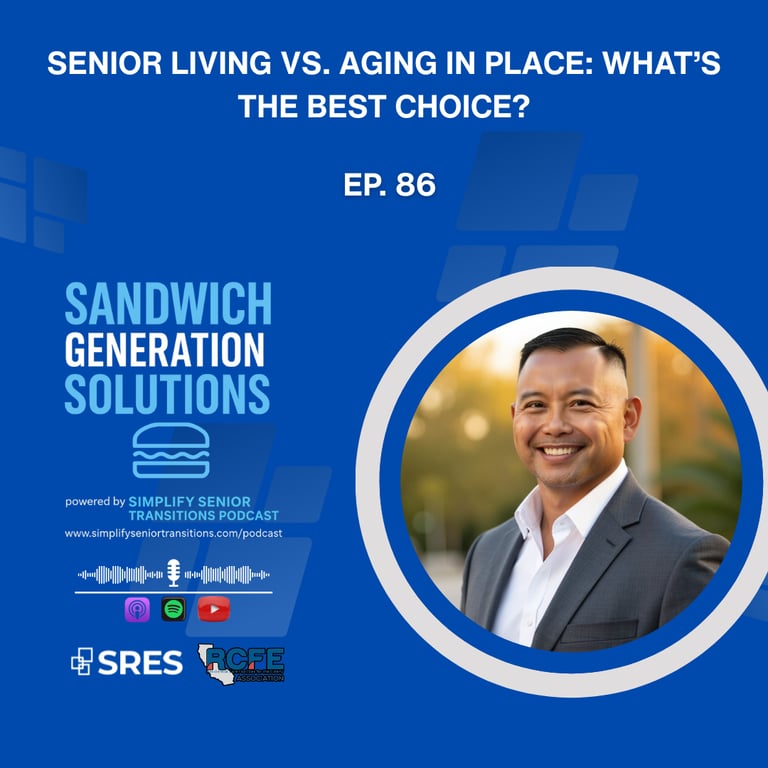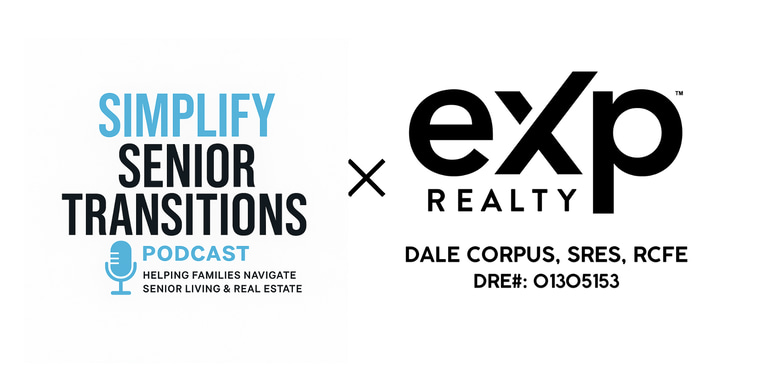Weighing the Options: Senior Living vs. Aging in Place in the Bay Area
Helping Bay Area Families Decide Between Comfort, Cost, and Care When Supporting Aging Parents
Dale Corpus
10/12/20253 min read
Weighing the Options: Senior Living vs. Aging in Place in the Bay Area
If you are one of the thousands of adult children in the Bay Area navigating the complexities of caring for an aging parent, you are not alone. Whether you’re in Contra Costa, Alameda, Santa Clara, San Mateo, San Francisco, Solano, or Napa County, the central question is often the hardest: Should Mom or Dad stay in their familiar home, or is it time to consider senior living?
This is not just a logistical choice; it is deeply emotional, often leaving family caregivers feeling overwhelmed and unsure of the next step. As a senior transition specialist based in San Jose, California, I help families navigate this exact decision and the subsequent home selling process.
Here's what you'll learn in this episode:
In this conversation, we break down the tough topics surrounding senior transitions:
The crucial pros and cons of Aging in Place versus moving to a Senior Living community.
Two essential factors to consider that will bring clarity to your decision.
The biggest mistakes families frequently make and practical strategies to avoid them.
How to make this significant life change as seamless and smooth as possible.
The Heart of the Matter: Why This Is So Difficult
Most seniors deeply desire to stay in their current homes for as long as possible because it is familiar, comfortable, and full of cherished memories. However, as needs evolve, families start grappling with hard questions: Can they still manage daily activities safely? What happens if their health suddenly declines? Is the current home truly the best place for them to thrive? The truth is that there is no single, one-size-fits-all answer.
Aging in Place: Comfort vs. Cost and Isolation
Aging in Place means your loved one remains in their existing home, perhaps with necessary modifications or additional external support.
Pros:
On the positive side, staying at home offers comfort and familiarity and can be emotionally comforting. In the short term, you may see cost savings by avoiding senior community fees, and many seniors feel greater independence and control over their daily lives.
Cons:
However, the cons often become significant long-term challenges:
Safety and Upkeep: Home safety concerns like accessibility issues, falls, and general home upkeep become major hurdles.
Escalating Costs: While you save on community fees initially, the costs of modifications (like grab bars or stairlifts) or in-home care can quickly add up. In the Bay Area, caregiving services typically range from $35 to $50 per hour. Full-time, comprehensive care often exceeds $10,000 per month, sometimes making it more expensive than senior living.
Social Isolation: Seniors who stay home alone are at high risk of loneliness, which negatively affects both mental and physical health.
Senior Living: Prioritizing Safety and Social Well-being
Senior Living Communities come in many forms—from independent living and assisted living to memory care and skilled nursing. A common misconception is that these communities are only for those needing acute medical assistance; in reality, many provide active Independent Living options with built-in support for future care needs.
Benefits:
The benefits of moving include safety and medical support, ensuring access to caregivers, medication management, and 24/7 assistance. Furthermore, planned activities, group meals, and community support foster social engagement, directly helping to prevent the isolation so prevalent with aging in place. Financially, Senior Living often provides predictable costs since fees typically cover housing, meals, and assistance, unlike the potentially fluctuating costs of in-home care.
Challenges:
However, this transition comes with emotional stress:
Emotional Adjustment: Moving out of the long-term family home is inherently difficult.
Downsizing Challenge: Seniors frequently have less personal space and must downsize their possessions, which itself is a highly emotional process.
Cost of Care: Depending on the level of care needed, Bay Area costs range from $4,500 to over $10,000 a month.
Choosing the Right Path
To gain clarity, focus on three key considerations:
Health and Mobility Needs: Assess whether your loved one can genuinely live safely at home or if immediate assistance is required.
Social and Emotional Well-being: Are they staying active and engaged, or are they exhibiting signs of isolation?
Financial Considerations: Compare the true long-term cost of managing in-home care versus the predictable monthly fee of senior living.
The ultimate goal is a decision that ensures your loved one’s quality of life, safety, and long-term happiness.
I understand how overwhelming this process feels, especially if you’re worried about selling their home, managing necessary repairs, or handling the transition smoothly. You do not have to navigate this alone.
Ready to Simplify Your Transition?
If you are contemplating senior living and need guidance on selling your loved one’s home or making the process smooth, I can help.
Schedule your FREE consultation today to discuss your unique situation at www.simplifyseniortransitions.com.
For quick questions, you can DM me directly on Instagram @soldbydale.
And be sure to listen to the full episode for detailed insights!
📧 P.S. Got news or an amazing story to share? Email me at dale.corpus@exprealty.com and you might be featured in our next episode! Remember to check out the transcript for more details. Happy listening!
Watch The Podcast Here



Transitions Made Simple
Helping seniors transition with ease and peace.
📍 Serving the San Francisco Bay Area
📞 Get in Touch
📬 STAY INFORMED
Dale Corpus, SRES, RCFE
📱 925-380-1657
🕓 Available for free 15 min consultations by appointment
© 2025. All rights reserved.
Sign up for monthly senior transition tips & real estate insights.
